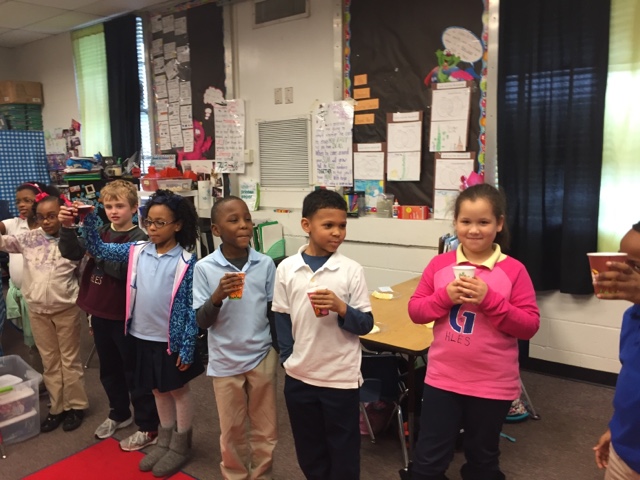Let me say, that even though we got the memory work down, it was just that... Memory Work. We didn't have to understand it, and kids who struggled with memorizing were left confused or even given more work. Common Core's purpose is building a deeper understanding of why times tables are used instead of addition, and why each number works is our focus. Even in kindergarten kids would say "Look Ms G, I know big kid math...1x1=1 or even 10x10=100." I'd just say "WOW". They've memorized something and got an exciting response so they kept saying it to anyone who'd listen...
If you think about, that's how we learned to talk! A baby or toddler would do something dangerous, or not polite, care-givers say "no!" After months of that kind of training, a baby mimics/says "no!" Everyone laughs, cheers, or does something to make the toddler like the response enough to say "no" again. Well, after months of our precious baby saying "no" to everything they finally realize that saying no to "Do you want ice cream?" is the wrong response! They they try out "yes" and "no" sometimes getting it right, sometimes not! We learn by trial and error.
Using the model of rectangular arrays is guided trial and error that helps the kids explore and understand why some things work and others don't. Look at this picture of 3 and 4 as the total number of blocks or the product of the numbers being multiplied.
The kids and I drew these patterns together up through number 12. (2016 Class has done up through 9 at this point.) Looking at the pictures for 3, they knew that they could only have 3 blocks total. I'd start by saying, "Draw 3 blocks side by side". In kindergarten we'd look at that and say, "I have 3 blocks." In 2nd grade we'd look at it and say, "I have 3 blocks in 1 row, that makes a rectangle." In 3rd Grade the kids would say "there are 3 blocks in 1 row, so 3x1=3." Only when the formation makes a rectangle or a square can those 2 numbers make a multiplication sentence.
Now, look at the pink picture for 3- if we draw 3 with 2 in each row, then the 3rd block would be by itself in row 2. In kindergarten, we would see 2 in top row plus 1 in bottom row equals 3. In 2nd grade however, we would look at it and see that it does not make a complete rectangle or square so we say 3 blocks in 2 rows does not make a rectangular array. In 3rd grade we would say we do not have a multiplication sentence that says 2 blocks times 2 rows equals 3.
For the orange-red set of 3, we decided that each row would get only 1 block. In kindergarten, we'd say "1+1+1=3". In 2nd grade talk, we say, "1 block in each row, and 3 rows in all makes a tall rectangle, so that is a rectangular array." In 3rd grade, they would say, 1x3=3. When there are only 2 ways to build that product, then that number is a prime number!
The kids have their first page in their Monster Folders. Here are pictures of my example for #s 1-12 keep in mind that we've worked on this together, it should not be new to your child.
1-6
Zameah from 2014 class said- "Oh, I get it! 1x anything is that number!"
Another student from 2014, Tyler said- "I know that if 1x10=10 then 10x1 is gonna work too because you just turn the blocks!
Jorge- when its odd, you can't have 2 rows.
Brayden noticed - "when its the same numbers, we made a square"
So why am I going into so much detail, explaining this to you? At the curriculum workshop in February of 2014, Mrs Brown (our math coach) told parents that the 3rd grade teachers want the kids to have multiplication facts memorized 0-10, when school starts in August. In 2nd grade our standards mandate that the kids have addition and subtraction facts memorized. That has been our focus, and I know that many of my kids are still struggling with subtraction. In regards to the standards, we are mandated to teach the 2nd graders the following information about rectangular arrays:
1. that they are repeated addition
2. That there is a correlation to multiplication
3. Show arrays up to 5 across and 5 down.
There is a large gap between our standards and memorizing multiplication facts. So it will fall to you over the summer to make sure your child practices and begins to memorize the multiplication facts while at the same time still able to add and subtract up to 20 immediately and without the use of their fingers.
Note to other 2nd grade parents... Ms Cox is teaching Rectangular Arrays. The kids are working on an array booklet with comparisons to multiplication. This is NOT something to stress out about and call Mrs Brown. We are focused on the kids mastering 2nd standards, and will not assess them on the multiplication facts this year, that is not in our standards. Please keep in mind that while we all teach the same material, we are all different. So it is expected that we teach differently! And honestly, that is a good thing!
My suggestion- Go by multiplication flash cards and keep them handy this summer!
Mrs G-Werner😉























































